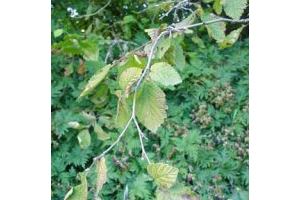Alnus is from an ancient Latin name derived from the Celtic meaning "growth along streams". Alnus alnobetula is sometimes planted on streambanks for flood control and erosion. Alnus alnobetula is native to the U.S. and is in the Betulaceae (Birch Family).
Photo Credit: © Chris Evans, River to River CWMA, Bugwood.org.
Alnus alnobetula
Common Name: green alder
Other Scientific Names: Alnus viridis
Plant Functional Group: Deciduous broadleaf
Class > Order > Family: Magnoliopsida > Fagales > Betulaceae
What does the species look like?
Alnus alnobetula is a fast-growing, perennial, large shrub or small tree reaching 12 to 36 feet in height. The bark is grayish-brown and smooth with raised pores (lenticels). The leaves of green alder are shiny, dark green, leathery, and fine-toothed along the edges. The male flowers are clustered yellow-green to brown catkins; female flowers are more cone-like in shape (strobiles). The fruits are oval, light brown, single-seeded, winged nuts (samaras) arranged on stalked clusters.
Alnus alnobetula can be found along streambanks, sandy lakes, shorelines, and bog edges, and on sandy or gravelly slopes or flats. This species can grow either alone or in thickets, and tolerates part shade to full shade and moist to wet, sandy soils. Green alders form nitrogen-fixing nodules on their roots with Frankia, an actinobacteria. Moose, caribou, and small mammals eat the twigs and foliage of
Alnus alnobetula . Birds eat the seeds, buds, and catkins.
Where is the species found?
States & Provinces
AB, AK, BC, CA, ID, MA, MB, ME, MI, MN, MT, NB, NC, NH, NL, NS, NT, NU, NY, ON, OR, PA, PE, QC, SK, TN, VT, WA, WI, WY, YT
Special Considerations for Observing
If drought seems to be the cause of leaf color or fall for a plant, please make a comment about it for that observation.
This species has separate male and female flowers. If you know whether the flowers you are observing are male or female (or both), please make a comment about it for that observation.
Which phenophases should I observe?
Do you see...?
Leaves
Breaking leaf buds More...
How many buds are breaking?
Less than 3 3 to 10 11 to 100 101 to 1,000 1,001 to 10,000 More than 10,000
Leaves More...
What percentage of the potential canopy space is full with leaves? Ignore dead branches in your estimate of potential canopy space.
Less than 5% 5-24% 25-49% 50-74% 75-94% 95% or more
Increasing leaf size More...
What percentage of full size are most leaves?
Less than 25% 25-49% 50-74% 75-94% 95% or more
Colored leaves More...
What percentage of the potential canopy space is full with non-green leaf color? Ignore dead branches in your estimate of potential canopy space.
Less than 5% 5-24% 25-49% 50-74% 75-94% 95% or more
Falling leaves More...
Flowers
Flowers or flower buds Alnus alnobetula , the male inflorescence is a catkin which is initially compact and stiff, but eventually unfolds to become longer and hang loosely from the branch. The female inflorescence is also a catkin which is very small, reddish, and has leafy scales. Once the female flowers wilt, the catkin turns green and grows thicker as the fruits develop.More...
How many flowers and flower buds are present? For species in which individual flowers are clustered in flower heads, spikes or catkins (inflorescences), simply estimate the number of flower heads, spikes or catkins and not the number of individual flowers.
Less than 3 3 to 10 11 to 100 101 to 1,000 1,001 to 10,000 More than 10,000
Open flowers Alnus alnobetula , the male flowers will open once the initially compact catkin has unfolded and is hanging loosely. Female flowers are open when the pistils are visible, but will be very difficult to see where they are out of reach.More...
What percentage of all fresh flowers (buds plus unopened plus open) on the plant are open? For species in which individual flowers are clustered in flower heads, spikes or catkins (inflorescences), estimate the percentage of all individual flowers that are open.
Less than 5% 5-24% 25-49% 50-74% 75-94% 95% or more
Pollen release More...
How much pollen is released?
Little: Only a few grains are released. Some: Many grains are released. Lots: A layer of pollen covers your palm, or a cloud of pollen can be seen in the air when the wind blows
Fruits
Fruits Alnus alnobetula , the fruit is a winged nutlet that ripens to tan or gold and is hidden within a small, scaled cone that changes from green to dark brown and whose scales are closed together. Do not include empty cones that have already dropped all of their nutlets.More...
How many fruits are present?
Less than 3 3 to 10 11 to 100 101 to 1,000 1,001 to 10,000 More than 10,000
Ripe fruits Alnus alnobetula , a fruit is considered ripe when the cone scales have begun to spread apart to expose the tan or gold nutlets. Do not include open cones that have already dropped all of their nutlets.More...
What percentage of all fruits (unripe plus ripe) on the plant are ripe?
Less than 5% 5-24% 25-49% 50-74% 75-94% 95% or more
Recent fruit or seed drop More...
How many mature fruits have dropped seeds or have completely dropped or been removed from the plant since your last visit?
Less than 3 3 to 10 11 to 100 101 to 1,000 1,001 to 10,000 More than 10,000
What do these phenophases look like?
There is currently no photoguide available for this species. If you'd like help us create one, use the guidance document and species template provided here . Then send it via email to education@usanpn.org when it is complete.
